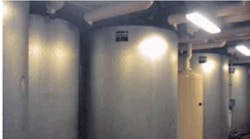Rockefeller Center in midtown Manhattan is one of the most recognized commercial properties in the world. Built during the Art Deco period of the early 1930s, the 10-building real-estate, shopping, and dining complex, which encompasses six square blocks and consists of approximately 8 million sq ft of rentable space, is home to NBC studios, Radio City Music Hall, and perhaps the world’s most famous ice-skating rink and Christmas tree.
The buildings of Rockefeller Center are served by a central chilled-water plant containing 14,500 tons of steam and electric chillers. Water is distributed through a primary water loop around the perimeter of the site. Six primary pumps—four with 6,000-gpm capacity at 125 hp and two with 2,000-gpm capacity at 50 hp—are located in the main plant. Seventeen primary chilled-water riser pumps, which range in size from 1,000 gpm at 40 hp to 3,500 gpm at 200 hp, send chilled water to heat exchangers located in each building. The secondary sides of the heat exchangers have pumps that serve air handlers and fan coils that serve tenant spaces.
Traditionally, one of the biggest challenges had been supplying chilled water at a temperature and flow satisfying tenant-comfort and lease requirements in all buildings throughout the year. While the supply and pumping capacity always had met requirements, co-owner and manager Tishman Speyer sought a way to deliver the water more efficiently and lower overall energy costs.
Storing Energy Is the Answer
After learning of the successful application of thermal storage in buildings throughout New York, Joseph Szabo, managing director of operations for Tishman Speyer, asked Fred Limpert of Trane and Mark MacCracken of CALMAC to determine the feasibility of applying Trane high-efficiency electric chillers and CALMAC ice-storage technology.
Trane and CALMAC spent the subsequent weeks investigating the financial and efficiency benefits of applying thermal-storage technology in Rockefeller Center.
Instead of meeting summer peak demand with a single electric chiller, Tishman Speyer elected to install an ice-making chiller sized to provide 8,600 ton-hours of energy storage. Especially during peak-demand periods, the ice-storage tanks are used instead of the electric chiller, keeping electricity demand as low as possible.
An additional benefit of the energy storage is greater operational flexibility. The stored cooling can be used as needed from a couple of hours to several hours to optimize plant efficiency while keeping demand and cooling costs low.
Because of the expansive footprint of the Rockefeller Center site, a number of locations were considered for a thermal-energy-storage plant. The optimal location was determined to be away from the main plant, on the opposite side of the property. This shifted the burden of pumping chilled water from the main plant to the outer buildings. As ice melt, or “burn,” enters the primary chilled-water loop, variable-frequency drives on the main plant’s primary chilled-water pumps can be ramped down.
Plant operators are able to run the primary chilled-water pumps at lower amperage levels. During summer, with ice burning during peak-demand periods (usually, noon to 6 p.m.), only one of the three chillers runs. (Typical burn times are 8 hr during summer and 15 hr during winter.) During winter, when cooling loads are low, operators can get by with only running the ice-making chiller at night—no chillers need to run during the day.
“The ice plant has provided a level of operational flexibility that has allowed my engineering staff to make intelligent decisions at any point in time that ensures we are able to balance tenant comfort with plant operational efficiency,” Szabo said. “The thermal-energy-storage installation has simplified plant operations, and we no longer have to make those tough, on-the-spot decisions as to when and if to turn on chillers in the main plant. Turning on chillers of this size can result in large electrical-demand cost penalties, especially in New York City, which has a high-electrical-demand utility rate structure.”
Ice = Frozen Assets
As Tishman Speyer began incorporating the energy-storage plant into its overall HVAC strategy at Rockefeller Center, it began to see a positive ripple effect on all aspects of the plant’s operation. While there was an immediate benefit in allowing plant operators to shift cooling loads, there was an added benefit in allowing plant operators to use the rate of burn to meet the needs of the buildings. Burn rate can be adjusted from four hours to 10 hours as needed, based on plant conditions.
Prior to the energy-storage plant, on peak cooling days, building engineers would run one 4,000-ton steam-turbine chiller, one 4,000-ton electric chiller, and one 2,500-ton electric chiller. Incorporating ice burn into the operation of the main plant allowed Tishman Speyer to avoid putting the 2,500-ton electric chiller online.
“Not only does the ice-storage refrigeration plant provide ‘banked’ cooling capacity for peak-demand periods during the day, it also increases your operational flexibilities to the assets during spring and fall seasons, when you can side-stream the ice reserve with smaller refrigeration machines to reduce your overall demand in shoulder months,” Szabo said.
The installation of a thermal-energy-storage system has improved the energy efficiency of Rockefeller Center and lowered overall energy costs.
Conclusion
Ice storage can be used for a variety of applications, from schools and hospitals to commercial office buildings and retail establishments. System design takes into account the number of chillers and tanks a building has, how often the chillers and tanks are online, if operators are needed, building size and use, and more.
While the operating staff at Rockefeller Center utilizes an ice chiller at night and a partial-storage strategy during the day, the staff at another building may utilize an ice chiller in conjunction with ice tanks to provide cooling during the day. Each installation is different, but for each, ice storage works to reduce cooling costs and peak electricity demand.
For Design Solutions author guidelines, call Scott Arnold, executive editor, at 216-931-9980, or write to him at [email protected].










